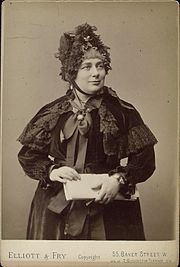Georgina Weldon's Human Design Chart
4/6 Sacral Manifesting GeneratorBritish campaigner against the lunacy laws, a celebrated litigant and noted amateur soprano of the Victorian era.
On 21 April 1860, against her father’s wishes, Georgina married William Henry Weldon, a lieutenant in the 18th Royal Hussars at Aldershot in Hampshire, causing her father to promptly disinherit her. In August 1860 she suffered a miscarriage when her husband threatened to kill her and himself.
By 1869 Weldon’s childless marriage was breaking down. At this time she devised a scheme for a National Training School of Music to teach music to poor children. The Weldons filled their home with orphans. She also joined Henry David Leslie’s famous choir, through which she met the French composer Charles Gounod in March 1871.
That year Georgina Weldon sang the solo in Mendelssohn’s Hear my Prayer at several venues in London, and took the solo soprano part in Gounod’s cantata Gallia at the Conservatoire de Paris and the Opéra-Comique in Paris. She published Hints for Pronunciation in Singing in 1872 as well as various songs and memoirs. It has been suggested that Georgina and Gounod were lovers. Gounod became increasingly disturbed by gossip about the “Weldon Affair” and in June 1874 he returned to his wife in Paris.
In 1880 and in 1885 she was imprisoned for libels connected with her musical career.
By 1875 the Weldons separated, and in 1878 Harry tried to use Georgina’s interest in spiritualism to prove that she was insane in an attempt to have her confined in a lunatic asylum. Georgina was seen by the necessary two doctors, and they then signed the lunacy order. She escaped and evaded capture for the seven days that the order remained valid. She then went to Bow Street Magistrates’ Court to press charges for assault. The magistrate sympathised with her and was convinced that she was sane, but, under Victorian law a married woman could not instigate a civil suit against her husband. However, having proved her point, Mrs Weldon publicised her story by giving interviews to the daily newspapers and the spiritualist press, in an attempt to provoke her husband and the two doctors into suing her for libel.
In 1882 Georgina Weldon successfully sued her husband for the restoration of her conjugal rights, but he refused to return to the marital home. The passing of the Married Women’s Property Act in 1882 allowed her to instigate the civil suit against her husband that she had wanted to pursue in 1878. In 1882 she published The History of my Orphanage, or The Outpourings of an Alleged Lunatic and How I Escaped the Mad Doctors. Between 1883 and 1888 she successfully sued all those involved in trying to have her committed in 1878, at one stage, in 1884, having seventeen cases in progress at the same time. She always represented herself and conducted all her cases without legal counsel. She became known as the “Portia of the Law Courts.”
Georgina Weldon’s final years were spent in London and Brighton. She died in Brighton on 11 January 1914.
Link to Wikipedia biography
Discover More Famous People
Browse and analyze over 55,000 public figures and celebrities.
Ra Uru Hu
5/1 Manifestor
Martha Stewart
4/6 Manifestor
David Lynch
4/6 Generator
Barack Obama
6/2 Projector
Steve Jobs
6/3 Generator
Vladimir Putin
5/1 Manifestor
Kim Kardashian
3/5 Generator
Michael Jackson
1/3 Projector
Marilyn Monroe
6/2 Projector
Ariana Grande
2/4 Projector
Oprah Winfrey
2/4 Generator
Johnny Depp
2/4 ManifestorWhat is HumanDesign.ai and how does it work?
Curious what makes Georgina Weldon tick? HumanDesign.ai instantly maps their exact birth data into a fully interactive clickable bodygraph chart, letting you hover or tap every center, channel, and gate for plain-language explanations. Bella, the platform’s built-in AI guide, adds context in real time, translating complex mechanics into everyday insights so you can see how Georgina Weldon’s strengths, challenges, and life themes play out on-screen.
The same tools are waiting for you. Generate your own Human Design Chart in seconds, open a library of 2000+ suggested questions, and chat with Bella as often as you like to decode your design, daily transits, and even relationship dynamics.
Want to compare energies? Save unlimited charts for friends, family, or clients, then ask Bella to reveal compatibilities, composite patterns, or coaching tips, all in one conversation thread.
Start free with core features, or unlock our Personal and Pro plans for deeper dives: unlimited Q&A, celebrity chart search spanning 55,000+ public figures, white-label PDF reports, branded content generation, and a professional profile with built-in booking for practitioners. Whether you’re exploring your own potential or guiding others, HumanDesign.ai delivers an ever-expanding toolbox of AI-powered insights—no spreadsheets, no jargon, just clarity at your fingertips.
Ready to see yours? Signup for FREE today!

